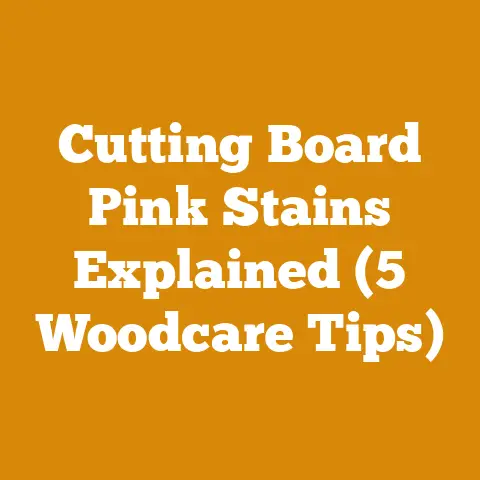Roundup for Japanese Knotweed: Effective Woodlot Control (3 Pro Tips)
Okay, let’s dive into the thicket and tackle Japanese Knotweed in our woodlots.
Imagine This: Your Woodlot Dream vs. Japanese Knotweed Nightmare
Picture this: you’ve finally acquired that piece of land you’ve always dreamed of. You envision yourself sustainably harvesting firewood, maybe even milling some of your own lumber. You see healthy trees, diverse wildlife, and a tranquil escape from the hustle and bustle of daily life. Now, imagine this idyllic scene slowly being choked out by a relentless, bamboo-like monster – Japanese Knotweed. It’s a nightmare scenario I’ve seen play out firsthand, and trust me, it’s a battle you want to win.
I’ve spent years working in and around woodlots, from helping clear land for sustainable forestry projects to simply gathering firewood for my own home. Over that time, I’ve seen the devastation Japanese Knotweed can wreak, and I’ve learned a few hard-won lessons about how to fight back. Many of us see Japanese Knotweed as an invasive species, and we are looking for a way to get rid of it. Roundup is one of the solutions we have at hand.
This isn’t just about aesthetics; it’s about the health and productivity of your woodlot. Knotweed aggressively outcompetes native plants, reduces biodiversity, and can even damage infrastructure like roads and foundations with its persistent rhizomes.
That’s why I’m sharing my experiences and insights on using Roundup (glyphosate-based herbicides) for effective knotweed control. I’m going to give you three pro tips that I’ve found to be essential for success. We’re not just talking about spraying and hoping; we’re talking about a strategic, informed approach that maximizes effectiveness while minimizing environmental impact.
Why Roundup? A Necessary Evil?
Before we get into the tips, let’s address the elephant in the room: Roundup. I understand the concerns about using herbicides, and I share them. I always prioritize non-chemical methods whenever possible. However, in many cases, especially with established knotweed infestations, Roundup is often the most practical and effective tool for the job.
Here’s why:
- Systemic Action: Roundup is a systemic herbicide, meaning it’s absorbed by the plant and translocated throughout its entire system, including the rhizomes. This is crucial because knotweed can regrow from even small fragments of rhizome.
- Proven Effectiveness: While other herbicides may have some effect, glyphosate has consistently demonstrated superior control of Japanese Knotweed in numerous studies and real-world applications.
- Selectivity (when applied carefully): With targeted application, Roundup can be used to selectively control knotweed without harming desirable vegetation.
However, it’s crucial to use Roundup responsibly and ethically. That means:
- Following label instructions meticulously: This is non-negotiable. The label is the law, and it contains vital information about application rates, safety precautions, and environmental considerations.
- Minimizing off-target spray: Use techniques like shielded sprayers or wiping to prevent the herbicide from drifting onto desirable plants or into waterways.
- Considering alternative methods: Explore non-chemical options like cutting, digging, and smothering, especially for small infestations or in environmentally sensitive areas.
- Understanding the bigger picture: Knotweed control is just one piece of a larger woodlot management plan. Think about how your actions will impact the overall health and biodiversity of your land.
I’ve seen firsthand what happens when Roundup is used carelessly. I once worked on a project where a contractor sprayed indiscriminately, killing not only the knotweed but also a large patch of native wildflowers and shrubs. It was a disheartening reminder that herbicides are powerful tools that must be used with respect and knowledge.
Now, with that understanding in place, let’s get to the pro tips.
Pro Tip #1: Timing is Everything – Nail the Application Window
This is arguably the most critical factor in successful knotweed control. You can use the best herbicide in the world, but if you apply it at the wrong time, you’re just wasting your time and money.
The ideal time to apply Roundup to Japanese Knotweed is in late summer or early fall, typically from late August to October, depending on your region. Here’s why:
- Maximum Translocation: During this period, the plant is actively transporting sugars and nutrients from its leaves down to its rhizomes for winter storage. This means that Roundup applied to the leaves will be carried along with these resources, effectively delivering the herbicide to the root system where it can do the most damage.
- Reduced Competition: Many other plants are starting to senesce (die back) at this time, reducing the potential for off-target spray.
- Favorable Weather Conditions: Late summer and early fall often bring cooler temperatures and more stable weather patterns, which can improve herbicide uptake and reduce the risk of drift.
Data Point: Studies have shown that glyphosate applied in late summer can result in up to 80-90% control of Japanese Knotweed, compared to only 30-40% control when applied in the spring.
I learned this lesson the hard way. Early in my woodlot management journey, I tried to tackle a knotweed patch in the spring, thinking I could get a jump start on the season. I sprayed diligently, but the knotweed just kept coming back. It wasn’t until I switched to a late-summer application that I started to see real results.
How to Determine the Right Time:
- Monitor the plant’s development: Wait until the knotweed is fully mature, with well-developed leaves and stems. It should be actively growing but not yet starting to senesce.
- Check the weather forecast: Avoid spraying on windy days or when rain is expected within 24 hours.
- Consult with local experts: Your local extension office or a certified pesticide applicator can provide specific recommendations for your region.
Actionable Takeaway: Mark your calendar for late summer/early fall and make knotweed control a priority. Don’t wait until the problem gets out of hand.
Pro Tip #2: The Right Mix – Boost Your Herbicide Power
Using the correct herbicide concentration and adding the right adjuvants can significantly improve the effectiveness of your Roundup application.
Herbicide Concentration:
Always follow the label instructions for the recommended application rate. However, for Japanese Knotweed, I’ve found that using a slightly higher concentration (within the label’s allowable range) can be beneficial. Knotweed is a tough plant, and it requires a strong dose to effectively kill the rhizomes.
Data Point: Research has shown that using a 2-3% solution of glyphosate can provide better control of Japanese Knotweed than a 1% solution.
Adjuvants:
Adjuvants are additives that enhance the performance of herbicides. They can improve herbicide uptake, reduce surface tension, and increase rainfastness. Here are a few adjuvants that I recommend for knotweed control:
- Surfactant: A surfactant helps the herbicide spread evenly over the leaf surface and penetrate the waxy cuticle. I prefer non-ionic surfactants, as they are less likely to damage desirable plants.
- Penetrant: A penetrant helps the herbicide move through the leaf cuticle and into the plant’s vascular system.
- Drift Control Agent: A drift control agent reduces the formation of small spray droplets, minimizing the risk of off-target spray.
My Go-To Mix:
For my knotweed control projects, I typically use the following mix:
- Roundup (glyphosate) at a 2.5% concentration
- Non-ionic surfactant at a rate of 0.5%
- Drift control agent at a rate recommended by the manufacturer
Example:
Let’s say you’re using a 4-gallon backpack sprayer. Here’s how you would calculate the amount of each ingredient to add:
- Roundup: 4 gallons x 2.5% = 0.1 gallons = 12.8 ounces
- Surfactant: 4 gallons x 0.5% = 0.02 gallons = 2.56 ounces
- Drift control agent: Follow the manufacturer’s instructions
Important Note: Always read and follow the label instructions for both the herbicide and the adjuvants.
Case Study:
I once worked on a project where we were struggling to control a large knotweed infestation using a standard Roundup application. After consulting with a professional applicator, we decided to add a penetrant to our mix. The results were dramatic. Within a few weeks, the knotweed started to show signs of decline, and the following year, we saw a significant reduction in regrowth.
Actionable Takeaway: Don’t just rely on Roundup alone. Experiment with different adjuvant combinations to find what works best for your situation.
Pro Tip #3: Application Technique – Get Targeted and Persistent
The way you apply Roundup is just as important as when and what you apply. Here are a few techniques that I’ve found to be particularly effective for knotweed control:
- Foliar Spray: This is the most common method, and it involves spraying the herbicide directly onto the leaves of the plant. Use a low-pressure sprayer to avoid drift and ensure thorough coverage.
- Cut-Stem Treatment: This method is ideal for small infestations or in areas where you want to avoid spraying desirable plants. Cut the knotweed stems close to the ground and immediately apply Roundup to the cut surface. This allows the herbicide to be absorbed directly into the plant’s vascular system.
- Injection: This is a more precise method that involves injecting Roundup directly into the stems of the plant. It’s particularly useful for treating knotweed that is growing near water or other sensitive areas.
- Wipe-On Application: Use a sponge or cloth saturated with Roundup to wipe the herbicide onto the leaves of the plant. This is a good option for controlling knotweed that is growing among desirable plants.
Persistence is Key:
Knotweed is a persistent plant, and it often requires multiple treatments to achieve complete control. Don’t get discouraged if you don’t see results after the first application. Be prepared to monitor the treated area and reapply Roundup as needed.
Data Point: Studies have shown that it can take 2-3 years of consistent Roundup applications to completely eradicate Japanese Knotweed.
My Preferred Method:
For most situations, I prefer a combination of foliar spray and cut-stem treatment. I’ll start by spraying the entire patch of knotweed with Roundup, and then I’ll go back and treat any remaining stems with the cut-stem method.
Real-World Example:
I once helped a friend clear a knotweed infestation from his property using this method. We started by spraying the knotweed in late summer, using a 2.5% solution of Roundup with a surfactant. We then went back and cut the remaining stems close to the ground, applying Roundup to the cut surfaces with a small paintbrush. We repeated this process for two years, and by the third year, the knotweed was almost completely gone.
Safety First:
- Always wear appropriate personal protective equipment (PPE) when handling herbicides, including gloves, eye protection, and a long-sleeved shirt and pants.
- Read and follow the label instructions carefully.
- Be aware of the potential hazards of Roundup and take steps to minimize your exposure.
- Store Roundup in a safe place, out of reach of children and pets.
Actionable Takeaway: Experiment with different application techniques to find what works best for your situation. Be persistent and don’t give up.
Beyond Roundup: Integrated Knotweed Management
While Roundup can be an effective tool for knotweed control, it’s important to remember that it’s just one piece of the puzzle. A truly effective knotweed management plan should incorporate a variety of strategies, including:
- Prevention: The best way to control knotweed is to prevent it from establishing in the first place. Be vigilant about scouting for new infestations and take action quickly to eradicate them.
- Manual Removal: For small infestations, you may be able to remove the knotweed by hand. This involves digging up the entire plant, including the rhizomes. Be sure to dispose of the plant material properly, as it can regrow from even small fragments.
- Smothering: Covering the knotweed with a thick layer of mulch or plastic can help to suppress its growth. This method is most effective when combined with other control strategies.
- Biological Control: There are currently no approved biological control agents for Japanese Knotweed in North America, but research is ongoing. In the UK, a psyllid insect (Aphalara itadori) has been released as a biological control agent, and it has shown some promise in reducing knotweed growth.
- Habitat Restoration: Once you’ve controlled the knotweed, it’s important to restore the native vegetation in the area. This will help to prevent the knotweed from re-establishing and will improve the overall health and biodiversity of your woodlot.
My Experience with Integrated Management:
On my own property, I’ve used a combination of Roundup, manual removal, and habitat restoration to control a knotweed infestation. I started by spraying the knotweed with Roundup in late summer, using the techniques I described above. I then went back and dug up any remaining plants by hand. Finally, I planted native trees and shrubs in the area to help restore the habitat. It’s been a multi-year process, but I’m finally starting to see real results.
The Long Game:
Controlling Japanese Knotweed is not a one-time event. It’s an ongoing process that requires vigilance, persistence, and a commitment to integrated management. But the rewards are well worth the effort. By controlling knotweed, you can protect the health and productivity of your woodlot and create a more beautiful and sustainable environment for future generations.
Final Thoughts: Your Woodlot, Your Responsibility
I hope these three pro tips have given you a better understanding of how to use Roundup effectively for Japanese Knotweed control. Remember, it’s not just about killing the plant; it’s about managing your woodlot responsibly and sustainably.
Don’t be afraid to experiment, learn from your mistakes, and seek advice from local experts. And most importantly, never give up on your dream of a healthy, thriving woodlot. It’s a journey worth taking.
Now, get out there and start reclaiming your land!






